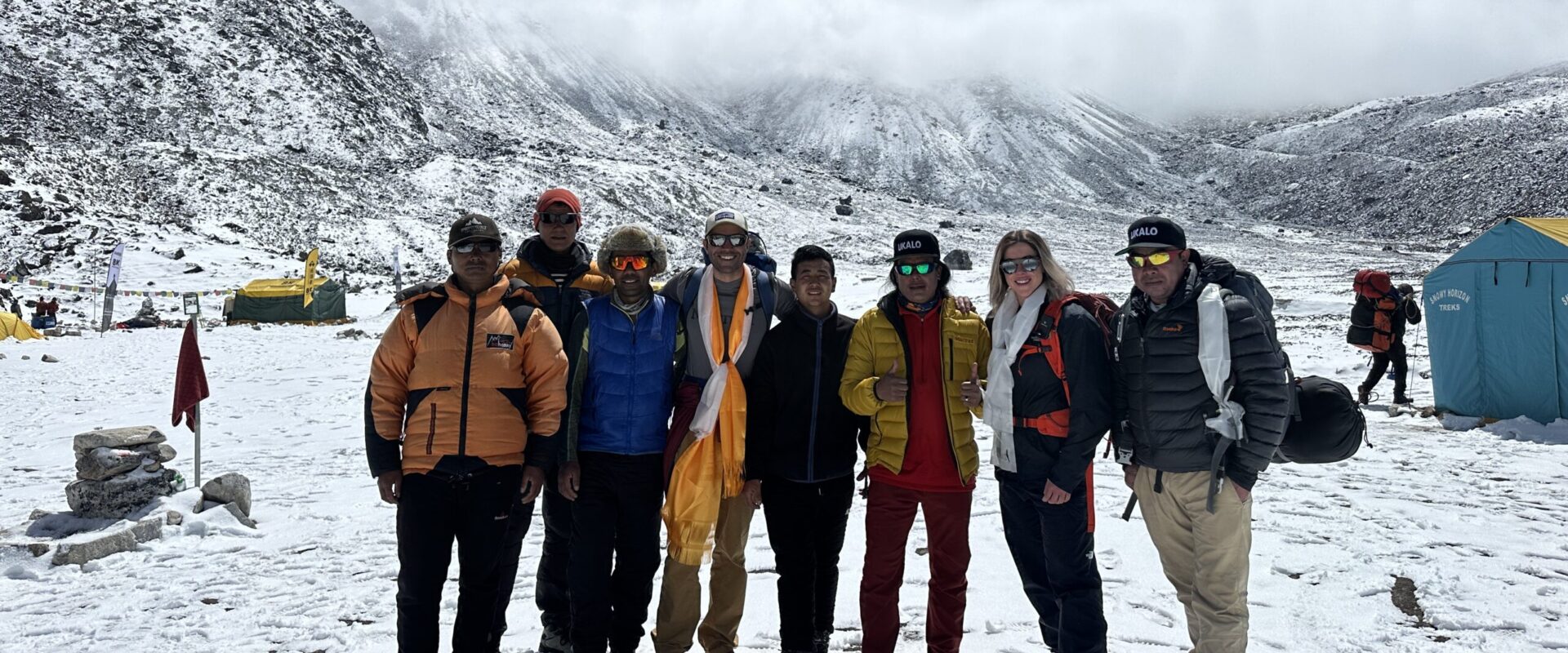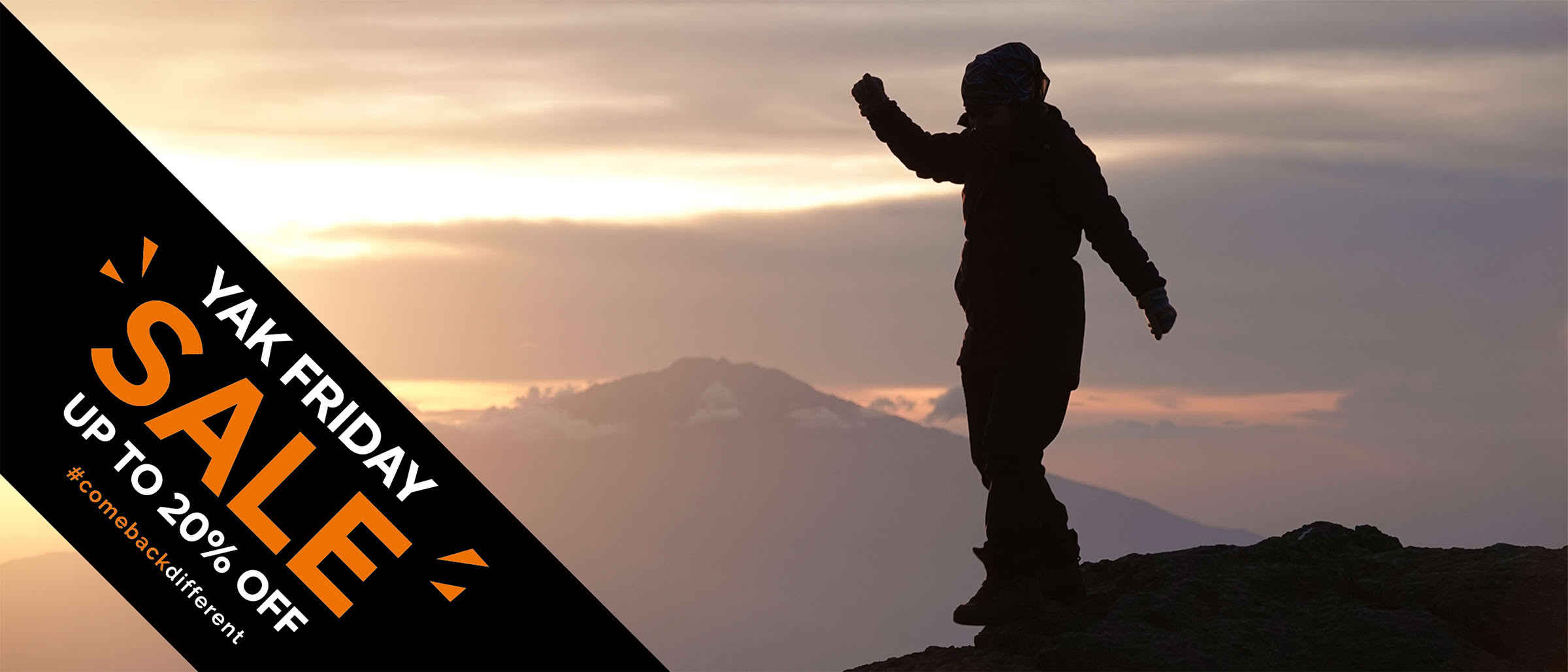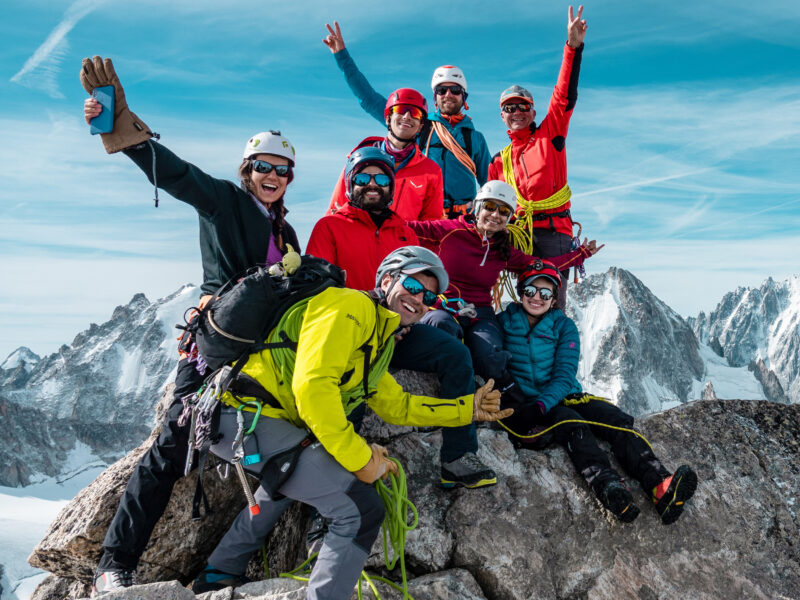BY Rami Rasamny | August 12 2025
The Definitive Guide to Climbing Ama Dablam

Ama Dablam is one of the most beautiful and recognizable mountains in the world. Rising 6,812 meters above the Khumbu Valley, its steep granite ridges, hanging glaciers, and sweeping fluted faces have earned it the nickname the Matterhorn of the Himalayas. For many climbers, it is the most striking peak they will ever see. For others, it is a lifelong dream — the climb they aspire to long before they first set foot in the high Himalaya.
This guide will take you through everything you need to know before attempting Ama Dablam — from its history and routes to the best time of year to climb, the skills you need, and how Life Happens Outdoors approaches one of the most remarkable climbs on earth.
A Brief History of Ama Dablam Ascents
Ama Dablam’s first recorded ascent took place in 1961 when a team led by Mike Gill, Barry Bishop, Mike Ward, and Wally Romanes reached the summit via the Southwest Ridge. This elegant line is still the standard route to this day, weaving through exposed granite towers and ice faces with almost constant technical interest.
The mountain’s name means Mother’s Necklace, a reference to the long ridges outstretched like protective arms and the hanging glacier — the dablam — that resembles the traditional pendant worn by Sherpa women. Today, Ama Dablam has become one of the most sought-after 6000-meter summits in the world, attracting experienced mountaineers from every continent.
When Is the Best Time to Climb Ama Dablam?
There are two climbing seasons for Ama Dablam: the pre-monsoon (April–May) and post-monsoon (October–November).
In recent years, the post-monsoon season has become increasingly busy. Many expeditions that once targeted 8,000-meter peaks in autumn now turn to Ama Dablam because of restrictions, weather patterns, or logistical changes, which means the mountain can feel crowded. The pre-monsoon period, however, often sees far fewer teams. With many high-altitude expeditions heading to 8,000-meter mountains during this window, Ama Dablam can sometimes feel almost empty — a rare gift in the modern Himalayan climbing scene.
Life Happens Outdoors runs expeditions in both seasons but leans toward pre-monsoon climbs for teams looking for more solitude and fewer traffic delays on the technical pitches.
How Long Does It Take to Climb Ama Dablam?
A typical Ama Dablam expedition lasts 25 to 30 days door-to-door, with at least two weeks spent above 4,500 meters. The climb itself is staged from Ama Dablam Base Camp at 4,600 meters and usually follows a three-camp system along the Southwest Ridge.
At Life Happens Outdoors, we do not use Camp 3 because of its position directly under large seracs that have been known to collapse. Instead, we summit directly from Camp 2, which makes for a long but far safer summit push. This approach reduces objective hazard without compromising the quality of the climb.
Route Selection: Which Route Should You Choose?
The Southwest Ridge is the classic and most frequently climbed route on Ama Dablam. It is a masterpiece of alpine climbing — sustained, exposed, and spectacular from start to finish.
While there are other lines on the mountain, including technical north and west face routes, they are rarely climbed and require a completely different level of commitment and logistics. For most climbers, the Southwest Ridge is the route of choice, and it remains one of the most aesthetic climbs anywhere in the world.
How Hard Is It to Climb Ama Dablam?
Ama Dablam is a technical climb that demands competence in rock, mixed, and ice climbing at altitude. Climbers must be able to:
- Climb confidently on sustained rock at grades up to 5.8 (UIAA V) while wearing mountaineering boots and sometimes with a pack.
- Move efficiently on steep snow and ice at 50–60 degrees.
- Navigate fixed lines and ascenders in exposed positions.
- Cope with long days at high altitude in cold, windy conditions.
While fixed ropes are in place along most of the route, prior experience in technical alpine climbing is strongly recommended. For those who have climbed peaks like Island Peak or Lobuche East and are comfortable on vertical terrain, Ama Dablam is a natural next step.
What Do You Need to Climb Ama Dablam?
Gear:
- Double mountaineering boots
- Crampons
- Ice axes (one technical and one mountaineering)
- Climbing harness with ascender and lanyard system
- Helmet
- Down suit or high-altitude down clothing
- Layered clothing system suitable for sub-zero conditions
- Glacier sunglasses and goggles
- Sleeping system rated for extreme cold
Skills:
- Proficiency in abseiling and ascending fixed lines
- Comfort climbing mixed terrain with and without fixed protection
- High-altitude camping experience
- Strong cardiovascular endurance and strength
Life Happens Outdoors provides a full gear checklist and support with rentals in Kathmandu. Our expeditions also include pre-climb skills refreshers at Base Camp to ensure every climber is confident with their systems before moving higher.
How Much Does It Cost to Climb Ama Dablam?
The cost of an Ama Dablam expedition varies widely depending on the operator, group size, and level of service. For a full-service guided climb, prices typically range from £8,000 to £18,000.
Our Life Happens Outdoors expedition includes:
- Full-service 25–30 day itinerary with acclimatization and climbing rotation schedule
- All accommodation in Kathmandu, lodges, and Base Camp
- Private Base Camp facilities with dining tents, communications, and dedicated kitchen staff
- IFMGA-certified expedition leadership with Sherpa support
- Group climbing equipment
- Professional climbing photography during the expedition
- A dedicated expedition coordinator before and during the trip
- Safer summit strategy avoiding Camp 3 hazards
- Flexible contingency days for weather
Why Choose a Guided Climb with Life Happens Outdoors?
Ama Dablam is not just another climb — it is a technical jewel of the Himalaya. Success here requires more than just fitness. It takes precision, judgment, and the right team around you.
Life Happens Outdoors brings together IFMGA-certified guides, experienced Sherpa climbers, and a dedicated support structure that makes every stage of the expedition smoother and safer. We believe in:
- Ethical partnerships with our Sherpa team, paying fair wages and ensuring world-class working conditions.
- Tailored acclimatization schedules that maximize summit chances while minimizing risk.
- Early and late-season departures for safer, less crowded climbs.
- Flexible and responsive expedition management.
- A strong community ethos that turns climbing partners into lifelong friends.
If you dream of standing on the summit of Ama Dablam with the Khumbu peaks spread out below you, we invite you to make that dream your next chapter.
Ready to join us? Explore the full itinerary and climb Ama Dablam with Life Happens Outdoors.
About The Author
Rami Rasamny is the founder of Life Happens Outdoors, a premium adventure travel community dedicated to transforming lives through curated outdoor experiences. A mountaineer and entrepreneur, Rami has led teams on some of the world’s most challenging peaks, from the Alps to the Himalayas. His mission is to make adventure accessible, transformative, and safe for all who seek to push their limits and Come Back Different.
About Life Happens Outdoors
At Life Happens Outdoors, we believe in the power of nature to transform lives. As proud members of the Adventure Travel Trade Association (ATTA) and the World Travel & Tourism Council (WTTC), our team of certified guides and outdoor professionals is committed to the highest standards of safety, sustainability, and excellence.
Discover more about our story and mission on our Meet LHO page, or explore our curated adventures such as the Tour du Mont Blanc Trek, the Climb of Kilimanjaro, and Chasing the Northern Lights.















